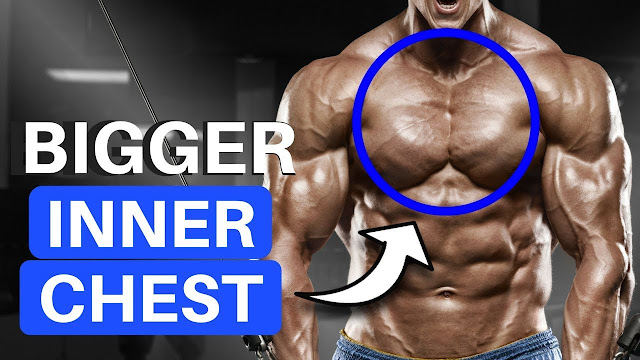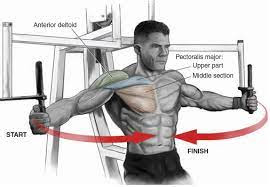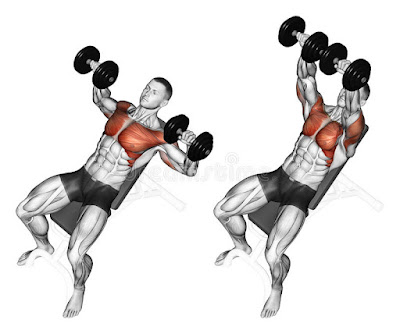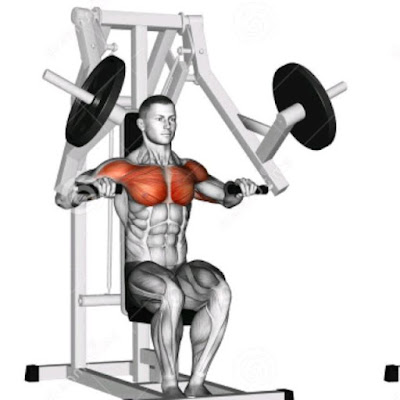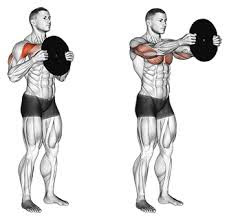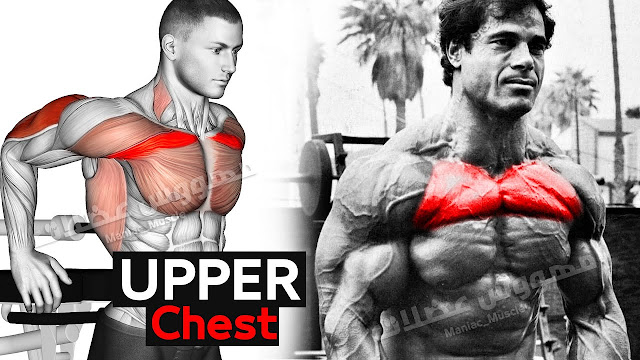How can I develop my inner chest and make it more defined?
For some people, chest day is everything. But even the most devoted chest-day lovers know that it's easy to bulk up your outer pecs and leave your inner pecs looking a little flat.
In this guide, you'll learn how to add size and definition to your chest by targeting the inner pecs.
How many sets and reps should you do to grow your pecs? What's the optimal training frequency for chest development? Should you train your chest once, twice, or three times a week? What about supersetting, how many reps per set, rest intervals and other factors that could enhance chest growth? We answer ALL those questions and more in this short article.
Read on to view our exercise guide to developing your inner pecs.
Anatomy of the pectoral muscles
The inner chest refers to the area that contains both the sternal and clavicular portions of the pectoral muscles. The inner chest is largely responsible for adduction, flexion, rotation, and depression of the humerus, as well as lateral flexion and medial deviation.
Any time you do a bench press or push-up, it's your stronger inner chest that gets used more than your weaker outer chest.
But, for some reason, your inner chest does not seem to grow as fast as the upper or outer chest. This part of the chest does seem easier to build for strength rather than hypertrophy.
It is still possible to add mass to the inner chest; you just need to be selective with your exercise and adapt how you perform each rep.
Pectoralis Major
The pectoralis major is the largest of your chest muscles. It covers the top and sides of your upper chest and runs from your collarbone to your shoulder blade. Its job is to bring your arm across your body.
The Pectoralis Minor
The pectoralis minor muscle is a thin, fan-shaped muscle located underneath the pectoralis major muscle in the front of the chest. The pectoralis minor helps to elevate the rib cage and move the scapula, or shoulder blade.
What is the Best Workout for the Inner Chest in the Gym
The inner chest muscles are part of the pectoralis major muscle group and can be strengthened with several chest exercises. So, what is the best workout for the inner chest that you can do in your gym?
Familiar exercises like bench presses and pec dec flyes also target this muscle group, so any time you do these regular chest workouts, you'll also work your inner chest muscles.
In this guide, we will look at isolation exercises that specifically target the inner chest as well as tips on how to adjust existing movements so that the inner chest is activated.
Many individuals find that they don't get a full contraction of their chest in the flat bench press simply due to the angle of their body and the fact that they are already used to a peaked position of their humerus bones.
For example, many athletes or individuals that have a "gorilla" posture (forward elongation of the spine) will find it difficult to peak horizontally.
Fly exercises are going to give you the best results when it comes to inner chest development. When used alongside heavy pressing movements, you are covering all of your bases and ensuring an all-around, well-developed chest.
These are the best inner chest workouts that you can perform in a well-equipped gym.
Pec Dec
The pec dec is hands down, the best equipment for developing the inner chest. Bodybuilders tend to go for the dumbbells for their flyes and overlook the pec dec but they are missing a trick.
When you get to the top of a dumbbell fly, there is little or no tension on the inner pectoral muscles as the dumbbell is supported directly above you.
On a pec dec, the tension remains constant on the inner pec throughout the movement and especially at the top of it.
Use a fast, powerful movement to bring your hands together, at the top of the movement, hold the position and squeeze the pecs for 5 seconds and then slowly release the fly for a further five seconds.
This squeeze and slow-release will put an emphasis on 'time under tension' for the inner pecs and allow for maximum development.
Dumbbell Flyes
Dumbbell flyes will not give you the same inner pec activation as the pec dec but the first part of the movement will put some tension on the inner chest.
Don't go too heavy and put extra emphasis on 'time under tension' as you lower the weights back to the starting position. After a few, slow controlled reps. you will feel the inner chest working.
Cable Flyes
Cable flyes are a great alternative if you do not have access to a pec dec. Make sure that you have a wide twin cable station so that your inner chest is doing most of the work.
You can use the same squeeze and slow-release method for the best inner chest activation.
Dumbbell chest press
If you like to add pressing exercises to your chest routine (and how doesn't!) opt for dumbbells instead of a barbell or smith machine.
The dumbbell chest press will allow you to bring your hands together at the top of the movement, which is where the inner chest does most of its work.
Cable press
The cable press is a better option than dumbbells for inner chest development. If you have a twin cable machine, slide the bench into the middle, set the pins at a low level, and press away.
You can also adapt the cable press into a cable press/fly movement so that you get the benefit of both movements.
Hammer press
Avoid using a seated press machine for inner chest development unless it is a hammer press. Fixed bar machines are good for overall chest development but do not allow you to bring your hands together and squeeze the inner pecs like a hammer press will.
Plate press
The plate press is a common inner chest exercise. It can be performed standing up for upper and inner chest development. Or lying on a bench if you want all of the focus on the inner chest.
The best inner chest workout at home
So, do you want to build big inner chest muscles at home? If so, you've likely looked high and low for the best exercises to target this 'hard to train' muscle group. Well, look no further! In this guide, we have compiled a list of the top inner-chest exercises for building a muscular chest.
Training the inner chest at home is going to be much harder than using a gym. You need a certain amount of resistance to really break down the muscle fibres and force adaptation.
If you can get your hands on some dumbbells or resistance bands, you can follow some of the fly exercises listed above. These are going to be the best methods for developing the inner chest.
If you have no equipment and are relying on body weight alone, try some of these movements.
Regular push ups
Regular push-ups are great for toning and developing the chest. To activate the inner chest, focus on slow movements, and maximum time under tension.
When the arms are fully extended and you have pressed your body right up, hold the position for a few seconds and squeeze the pecs before slowly lowering to the ground.
Do this slow, controlled movement until you find it really taxing (6-10 reps ideally) and then quickly pump out a few more reps with a faster movement. This will really break down the fibres in the chest muscles and force adaptation.
Incline push up
An incline push up is far easier than a regular or decline push up so add this to the end of your workout when the pecs are already fatigued to get the maximum benefit.
If you use the same slow, controlled motion as recommended with the regular push up, you will place emphasis on the inner and lower part of the chest.
To perform an incline push up, simply find a sturdy support that is about waist height, place your hands on it, step back so that you can straighten your entire body and perform a push-up movement.
The lower your support, the harder the exercise and the lesser emphasis on the lower chest.
Decline push up
The decline push-up is performed by elevating your feet. It targets the upper portion of the chest and, if performed as recommended, also activates the inner portion of the chest. Super-setting all three push-up movements in a circuit is the best way to get a good, all-around chest workout.
Chest flyes
If you do not have dumbbells or kettlebells, it can be a little trickier to do chest flyes at home. Look around your house for a pair of anything that has a bit of weight to it.
Filling up water bottles, bricks or any other heavy item will do. You need a little resistance so that you can put the muscles under tension.
Lying on a bench will give you the best stretch for your flyes, but if you do not have one, lie on your bed or just on the floor. Put all of your focus into the squeezing motion and the slow lowering of the weight for maximum results.
How often can I do a chest workout?
It's time to get pectacular! Chest workouts should be performed at least twice a week but can be done up to five times a week if you are not pushing it too hard on each session.
To work the chest, make sure you're using shoulder-width grips on your incline bench press.
When selecting a bodybuilding routine or strength training plan, look at how you can minimize recovery time for the different muscles so that you can train them as often as possible.
Bodybuilders should take a look at our HyperGrowth training split. This is a scientifically backed program for anybody seeking maximum hypertrophy.
Bodybuilder chest training frequency
If you are seeking hypertrophy, the best bet is to aim for 2-3 chest workouts a week. After a heavy chest session, it can take 2-4 days for the muscles to fully recover. This is dependent on your experience, age, nutrition, supplementation and genetics.
Some bodybuilders will only work the chest out once per week. This is fine if you are cycling steroids and your body is staying in a constant anabolic state, but for a natural lifter, the maximum benefit is going to come from training 2-3 times a week.
Take a look at our free hypertrophy training program to get the most from your training by clicking this link.
Another option is to train your chest every day, but only with 3-4 sets. Full-body workouts are becoming more popular with advanced trainers as they allow you to spread your total sets over the week instead of compressing them into 2-3 workouts.
You do not get the 'pump' that you would get from a dedicated chest day, but you also do not have to worry about skipping a dedicated leg day.
Strength trainer chest training frequency
Unless you are following an accumulation program, inner chest accessory exercises should be included at the end of your upper body workout or 'pressing' days.
This is typically going to be once or twice a week. If you only carry out presses once per week, use a couple of inner chest accessory movements after one of your leg days for maximum development.
If you like the idea of training your entire body, including your chest, every day, take a look at our free strength training program, HyperStrength by clicking this link.
Will developing my inner chest make me stronger?
Your inner pecs play a big role in assisting with your bench press when you are locking out the weight at the top of the lift. With that said, having a core to overall chest strength ratio will make it easier to lock out the weight.
In short, if your inner pecs are built stronger than your chest, you can push more weight, but this is all relative to other strengths such as your triceps and shoulders.
Your inner chest muscles play a vital role in your chest's strength, especially in bench pressing strength; they help support the rest of your chest while you lift.
Will developing my inner pecs make my chest bigger?
Get ready to feel your chest start to grow. After all, they are your inner pecs- they already do most of the work, so why not make them bigger.
The exercises detailed above will help target that inner area of the pec muscle so that you get that extra boost in this often neglected area.
By adding targeted movements to your inner chest, upper chest and lower chest on your chest training day, you will be ensuring maximum hypertrophy.
If you already have a big chest and just want a definition between the two muscles. Targeted inner chest workouts are going to help you achieve this.
Chest definition is going to be determined by three major factors...
- Genetics - Some people have a naturally defined chest and require very little work to develop the chest muscle fibres.
- Body fat % - To get a great definition between the two pectoral muscles, you are going to have a fairly low body fat %.
- Developed muscles - It goes without saying, you are not going to get a definition between the pectoral muscles if you do not have the muscles to define in the first place!
There is not much that can be done about the genetics side of things, but we can control the other two factors. Regular weight training, a clean diet and control of our nutrition will all help us to get the best-defined chest possible.
How can I develop my lower chest?
It is easy to develop your lower chest within a well-equipped gym with targeted resistance training. Free weights, a selectorized machine, or bodyweight exercises are all ways you can increase the size of your lower pectoral muscles.
These are the best exercises that you can use for developing the lower section of the pectoral muscles.
- Chest Dips
- Pec Dec - High seat
- Decline bench press
- Decline dumbbell press
- Dumbbell pullovers
- Incline push-up
How can I develop my upper chest?
Upper pecs are all about first impressions. Friends, colleagues, and loved ones will notice your upper chest before any other part of your body.
The upper pec region is a sought after muscle group to develop in the chest. Yet, it's the hardest area to actually build. The key to a successful pec development program is activating upper pec fibres through proper exercise and supplement programs.
These are the best exercises for upper chest development.
- Incline bench press
- Incline dumbbell press
- Standing cable flyes
- Pec dec, low seat
Takeaway
Bigger pecs don't always come naturally; sometimes, you have to work at it a little.
A complete regimen of weight training and good nutrition is necessary to see results. If you want bigger pecs don't rely solely on the bench press. You can build a bigger chest with push-ups, incline bench presses, dips, or even flat bench presses.
Make sure to lift heavy but not too heavy. Focus on connection and 'time under tension'.
Your muscles need time to recover so you should wait until they're ready to lift again.
Stay away from the gym for a few days, just to let your muscles rest and regroup before hitting the weights again, and always remember to warm up with light exercise before each session.
After that, it's time to gear up and hit the gym!
